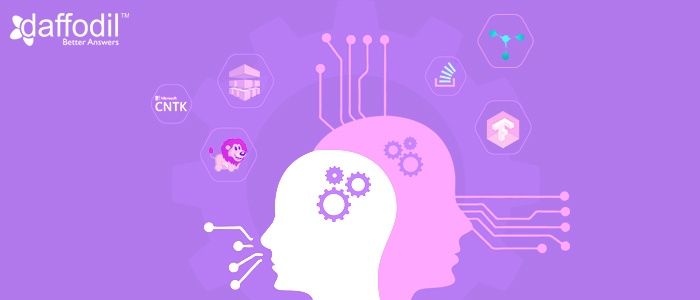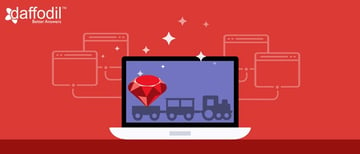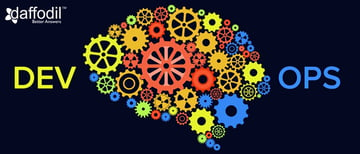
Machine Learning (ML) has turned out to be one of the profound applications of Artificial Intelligence (AI). From Virtual Assistants to traffic predictions, ML is refining the way some of the conventional tasks are performed. With ML holding its strength in pattern recognition and cognitive learning, it has found its significance in intelligent application development.
With this, a number of Machine Learning frameworks are introduced, enabling developers to make intelligent apps. And this has made possible without big data, with on device processing, and minimum lines of code. So here we bring up 5 best ML frameworks that can aid developers in smart application development, for both, web and mobile.
1. Tensorflow by Google
Tensorflow by Google is a framework for creating Deep Learning models. Deep Learning is a class of Machine Learning, wherein Artificial Neural Networks (ANNs) are used to make the systems learn and progressively improve a task by considering examples, usually without task-specific coding.
This framework is based on computational graph, which comprises of a network of nodes. Each node is an operation, running some function and this function could be as simple as a normal mathematical operation or as complex as multivariate analysis.
Tensorflow is a part of various Google services that we use today. Some of the names includes Google Photos, Google Recognition, Google Search, and more. Even, Google Translate’s instant visual translation uses this framework at the backend for on-device processing.
The framework is quite mature and can be a part of mobile apps that are being developed today. It’s caliber can be manifested with its usage by companies like Snapchat, Dropbox, Deepmind, Twitter, Uber, Intel, etc.
Supported Platforms: Android, iOS, Linux, Mac, Windows
2. Core ML by Apple
Core ML is a Machine Learning framework that’s being used across Apple products like QuickType, Siri, and Camera. Apple launched it in the WWDC 2017 for intelligent iOS app development.
With this ML framework, developers can build computer vision machine learning features into the iOS apps (i.e. making apps capable of performing tasks that human eyes do). Some of supported features include object tracking, face detection, text detection, face tracking, barcode detection, and more.
Also, Core ML offer Natural Language Processing APIs, alongside Machine Learning in order to understand the text thoroughly. For this, it uses tokenization, language identification, part of speech, lemmatization, and related features.
Developers can choose from the variety of ML models available like MobileNet, Squeezenet, Places205-GoogLeNet etc. These models helps to differentiate between the type of task to be done with ML. Either, these ready-to-use ML models can be used or developers can use the Core ML tools to convert a model into core ML model. To get started with it, Apple offers Core ML documentation available for developers.
Supported Platforms: iOS 11.0+
3. Amazon Machine Learning
Amazon Machine Learning service ensures that ML is implemented into the mobile apps by developers of all skill levels. With this framework by Amazon, developers get the visualization tools and wizards that enable the developers to build ML models without complicated algorithms or technologies.
Once the ML models are ready, the APIs can be used to obtain predictions from the model. No custom prediction generation code required. No infrastructure management needed.
With AML, there is no cost for hardware or software. For assistance, developers are provided with platform-specific guides to get started that informs them about the pre-requisites, client creation, offer examples, and more.
Supported Platforms: Android, iOS
4. Microsoft Cognitive Toolkit
This Machine Learning framework by Microsoft enable Deep Learning algorithms to work under range of environment, from CPU to GPU to multiple machines. Currently, a number of commercial grade AI applications have been developed and rendered using Cognitive toolkit. Some of the popular names include Cortana, Bing, Xbox, Skype etc.
It enables building the Deep Learning models using C++, Brainscript, and Python. Therefore, modifying the existing model is easy for developers as underlying, there are some familiar languages used.
Supported Platforms: Windows, Linux
ALSO READ: Machine Learning Examples from Day-to-Day Lives
5. Caffe Deep Learning Framework
Caffe is one of the popular Convolutional Neural Networks (CNNs) that offer ease in tasks like image classification, machine vision, recommender system etc. It is known for its Model Zoo, which is a pre-trained ML model for performing different tasks.
This ML framework for application development is however not meant for non-computer vision tasks such as sound, time series, or text. And the benefit of it is that you can actually run it on variety of hardware and switching between CPU and GPU is set with a single flag.
Supported Platforms: Linux, Windows, Mac
How to Build ML Powered Applications
Currently, we have mobile and web applications in varied domains that make use of Machine Learning. From eCommerce to FinTech to Healthcare, every industry is making the most of intelligent machines. And thus, AI application development services have seen a staggering hike in the recent times.
While these frameworks can help, they do need an expert hand for successful execution of required task. For any inquiry or to hire AI development experts, we are available with our free consultation services.



